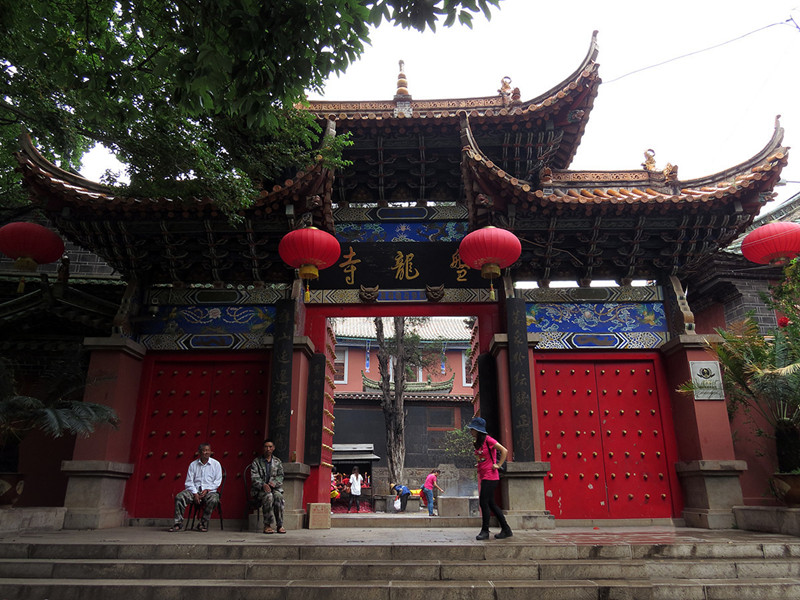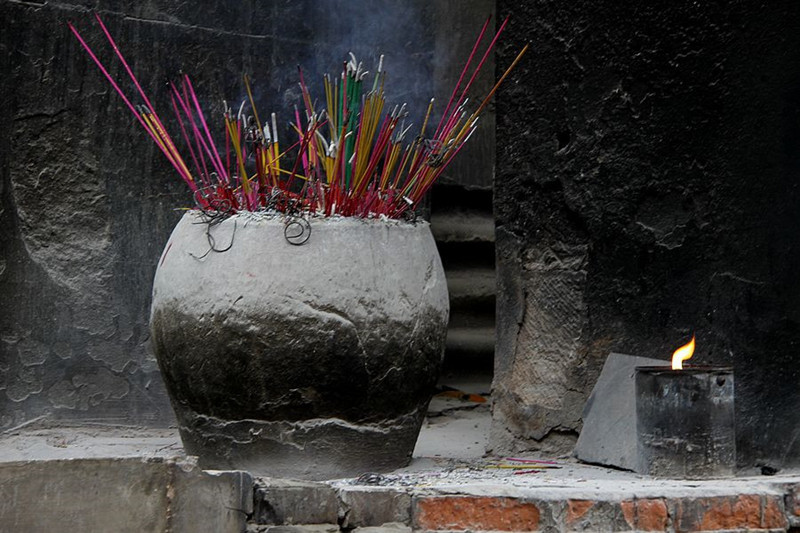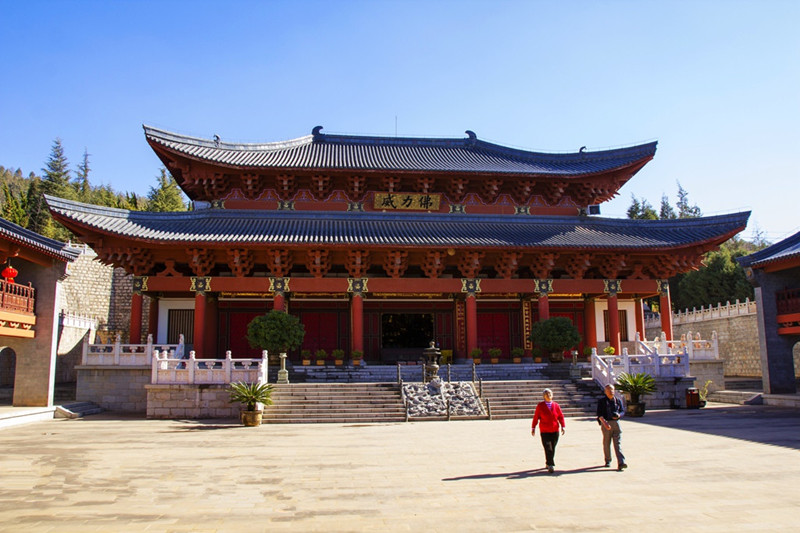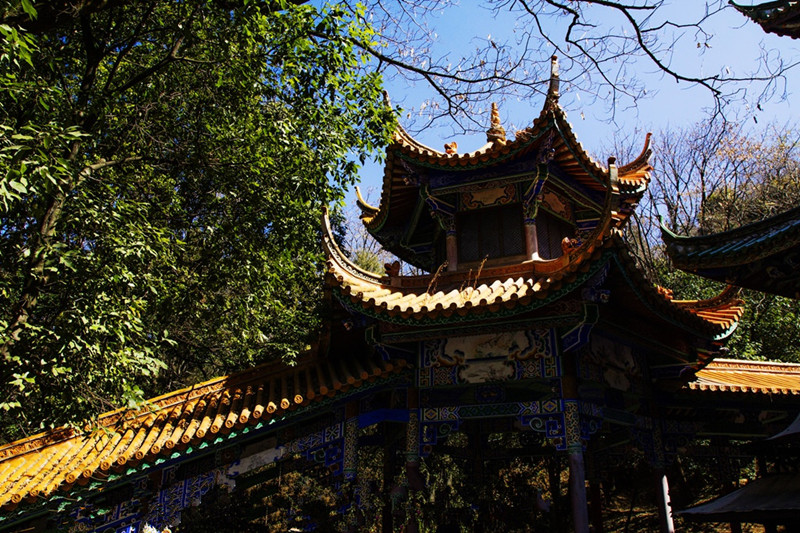
Panlong Temple in Jining District, Kunming
Overview
Panlong Temple (盘龙寺) is one of the most popular temples in Kunming (昆明), located on the eastern shore of Dianchi Lake (滇池) in Jining District (晋宁区), approximately 40 kilometers from downtown Kunming. Along with Xishan (西山) and Jizu Mountain (鸡足山) in Binchuan (宾川), it is known as one of the three major Buddhist sacred sites in Yunnan (云南).
Established in 1983 as a key cultural heritage site in Kunming, Panlong Temple was closed to the public on November 28, 2022, with the reopening date yet to be announced.
- Chinese Name: 盘龙寺
- English Name: Panlong Temple
- Location: On Panlong Mountain (盘龙山), 5 kilometers east of Jincheng Town (晋城镇), Jining District, Kunming
- Climate: Subtropical monsoon climate
- Opening Hours: Year-round, 7:30 AM – 5:30 PM
- Ticket Price: 8.0 RMB
- Major Attractions: Tianguan (天门), Yinxian Bridge (迎仙桥), Sleeping Buddha Hall (睡佛殿), Luzu Hall (吕祖殿), Master Hall (祖师殿), Mahavira Hall (大雄宝殿)
- City: Kunming, Yunnan Province (云南省昆明市)
- Country: China (中国)
- Best Seasons to Visit: All year round
- Official Phone Number: 0871-67811064
Historical Development
Panlong Temple was established in the seventh year of the Yuan Dynasty (元至正七年, 1347 AD) by the monk Lianfeng (莲峰和尚). Over its more than six hundred years of history, the temple has endured significant hardships. In the seventeenth year of the Daoguang Emperor’s reign (公元1837年), an 8.0 magnitude earthquake devastated most of the temple’s buildings. Additional destruction occurred during the Xianfeng (咸丰) and Tongzhi (同治) periods due to military conflicts.
In the fifth year of the Guangxu Emperor’s reign (公元1879年), local communities raised funds to rebuild the temple. After suffering further calamities in the late 1960s, Panlong Temple began restoration efforts in the 1980s and gradually regained its former glory.
During its peak in the Ming Dynasty (明代), Panlong Temple had dozens of structures, 450 rooms, and over 1,000 Buddha statues. Today, the temple features pavilions, towers, ancient bells, and numerous steles, showcasing exquisite architecture and a variety of styles, making it one of the top cultural heritage sites in Yunnan.
Temple Collections
Many renowned poets and scholars have left behind poems, calligraphy, couplets, horizontal plaques, and inscriptions at Panlong Temple. The works of Emperor Yongli (永历帝), King Liang of the Yuan Dynasty (元梁王), the great traveler Xu Xiake (徐霞客), and other prominent figures such as Dan (担当), Qian Nanyuan (钱南园), and Yuan Jiagu (袁嘉谷) are particularly valuable.
There are over a dozen ancient steles with significant cultural value, including the “Inscription on the Baoyun Pagoda of Master Dajue” (《大盘庵大觉禅师宝云塔铭》), “Record of the Complete Zen Monastery” (《具足禅院碑记》), “Initial Establishment Stele of Panlong Temple” (《盘龙寺初立常住碑》), and “Imperial Edict Stele of Emperor Yongli” (《永历帝敕文碑》), which have all been classified as Kunming municipal cultural heritage.
Related Legends
The “Inscription on the Baoyun Pagoda of Master Dajue,” established at the end of the Yuan Dynasty (元朝末年), is located under the left corridor of the Master Hall and commemorates Master Chongzhao’s (崇照大师) achievements in spreading Zen Buddhism and establishing Panlong Temple.
According to legend, when the temple was founded, this area was a dragon pond hidden in a valley. A dragon lived here, and Master Lianfeng chanted incantations to drive it away. Afterward, the pond dried up, and he built the temple, naming it Panlong Temple. Another version of the story suggests that there were originally six dragons in the pond, five of which were driven away, while one dragon remained and caused disturbances. Master Lianfeng subdued it, making it his steed. As the number of followers grew, so did the temple’s incense offerings, and soon after, Master Lianfeng passed away, being revered as “Master Panlong.”
In the early Ming Dynasty (明朝), the founder Monk Yuanzu (祖源和尚) expanded Panlong Temple, adding the Scripture Building (藏经楼) and Guanyin Hall (观音殿), giving it a more substantial form. According to the travel notes of Xu Xiake, “Master Lianfeng of Panlong Mountain, named Chongzhao, attained Nirvana on the 18th of August during the Yuan Zhizheng era… to this day, this has become the Panlong Festival” (《徐霞客游记》记载:“盘龙山莲峰祖师,名崇照,元至正间以八月十八日涅槃……至今日以此为盘龙会。”).
Visiting Routes
Nestled in the tranquil surroundings of Panlong Mountain, reaching this Buddhist sanctuary requires passing through “Four Gates.” Start from the eastern gate of Jincheng, marked by the “South Yunnan Spiritual Realm” archway, the “Entrance” gate. Next, proceed past the remnants of the Xiangshan Academy (象山书院) to reach the mountain gate, known as the “Mountain” gate. After passing Yingshan Lake (映山湖), ascend further and go through three heavenly gates, representing the “Heaven” gate. Finally, passing the Sleeping Buddha Hall and Luzu Pavilion (吕祖亭), you will arrive at the temple gate, the “Buddha” gate, which also serves as the “Tao” gate and “Holy” gate. Entering these four gates, one transcends the mundane, as if stepping into a realm of immortality, where the gifted and the divine converge at Panlong.
Panlong Temple Fair
Every year on the first day of the eighth lunar month, the Panlong Temple Fair (盘龙庙会) takes place. On this day, thousands of pilgrims and tourists flock to the temple to worship and celebrate, with most visitors coming from Kunming, Chenggong (呈贡), Kunyang (昆阳), and Yuxi (玉溪). The atmosphere is lively and bustling, unmatched by any other temple fair in the Kunming area.
Scenic Features
Panlong Temple is home to centuries-old trees and flowers, including tea flowers from the Yuan Dynasty, red plums from the Ming Dynasty, and silver osmanthus from the Qing Dynasty (清代). These trees continue to bloom every year, attracting countless flower enthusiasts.
Within the temple, there is a small courtyard known as the “Tea Flower Hall” (茶花殿), featuring two camellias purportedly planted by Master Lianfeng, which are over 600 years old. One tree produces large flowers, known as “Lion’s Head” (狮子头), which are bigger than a bowl and display vibrant colors. Another tree, “Soft Branch Pine Cone” (软枝松子鳞), stands over two meters tall, showcasing prized varieties.
Temple Scenery
Panlong Mountain spans several dozen miles, with its majestic main peak surrounded by mountains, the sound of pines echoing, and the towering central peak named “Panlong.” The name of the mountain reflects its form, as described by Qing Dynasty poet Zhou Hualin (清代周华林): “The winding mountain seems to coil like a dragon, with treetops concealing the temple and clouds veiling the exquisite peak” (蜿蜒山不断,作势欲盘龙,树杪藏箫寺,云根隐秀峰).
Transportation Information
- Take a minibus from East Station (东站) to Jiangchuan or Tonghai, getting off at Jincheng Panlong Temple (票价约15元).
- Direct buses to Panlong Temple depart from under the Kunming Chrysanthemum Interchange Bridge (昆明菊花立交桥), with tickets priced between 15 RMB and 20 RMB.
Major Attractions
Panlong Temple is constructed in accordance with the mountainous terrain, featuring the Three Heavenly Gates (一、二、三天门), Yinxian Bridge, Sleeping Buddha Hall, Luzu Hall, Master Hall, Mahavira Hall, Jade Emperor Pavilion (玉皇阁), Kṣitigarbha Hall (伽蓝殿), and Medicine Buddha Hall (药师殿), among over 20 courtyards. It serves as a sanctuary for the deities of Buddhism, Taoism, and Confucianism, with the Master Panlong Hall, Medicine Buddha Hall, and Guanyin Hall being particularly popular. The temple’s surroundings are rich in lush vegetation, renowned for its tea flowers and cypress trees. Originally home to Wansong Temple (万松寺), it now features the tall Guanhai Pavilion (观海楼), where visitors can enjoy panoramic views of Dianchi Lake and the distant Xishan Mountain.
Highlights:
- Discover the cultural relics and ancient inscriptions in the temple.
- Explore the lush gardens and majestic ancient trees.
- Experience the peaceful atmosphere ideal for meditation and reflection.
- Participate in the annual Panlong Temple Fair for a local cultural experience.
Travel Tips
- Best Time to Visit: Early mornings are ideal for tranquility and meditation.
- What to Wear: Comfortable clothing and shoes for walking.
- Food and Drink: It is advisable to bring water and snacks, as local food options may be limited.










 7 Days GolfingTour
7 Days GolfingTour
 8 Days Group Tour
8 Days Group Tour
 8 Days Yunnan Tour
8 Days Yunnan Tour
 7 Days Shangri La Hiking
7 Days Shangri La Hiking
 11 Days Yunnan Tour
11 Days Yunnan Tour
 6 Days Yuanyang Terraces
6 Days Yuanyang Terraces
 11 Days Yunnan Tour
11 Days Yunnan Tour
 8 Days South Yunnan
8 Days South Yunnan
 7 Days Tea Tour
7 Days Tea Tour
 8 Days Muslim Tour
8 Days Muslim Tour
 12 Days Self-Driving
12 Days Self-Driving
 4 Days Haba Climbing
4 Days Haba Climbing
 Tiger Leaping Gorge
Tiger Leaping Gorge
 Stone Forest
Stone Forest
 Yunnan-Tibet
Yunnan-Tibet
 Hani Rice Terraces
Hani Rice Terraces
 Kunming
Kunming
 Lijiang
Lijiang
 Shangri-la
Shangri-la
 Dali
Dali
 XishuangBanna
XishuangBanna
 Honghe
Honghe
 Kunming
Kunming
 Lijiang
Lijiang
 Shangri-la
Shangri-la
 Yuanyang Rice Terraces
Yuanyang Rice Terraces
 Nujiang
Nujiang
 XishuangBanna
XishuangBanna
 Spring City Golf
Spring City Golf
 Snow Mountain Golf
Snow Mountain Golf
 Stone Mountain Golf
Stone Mountain Golf




